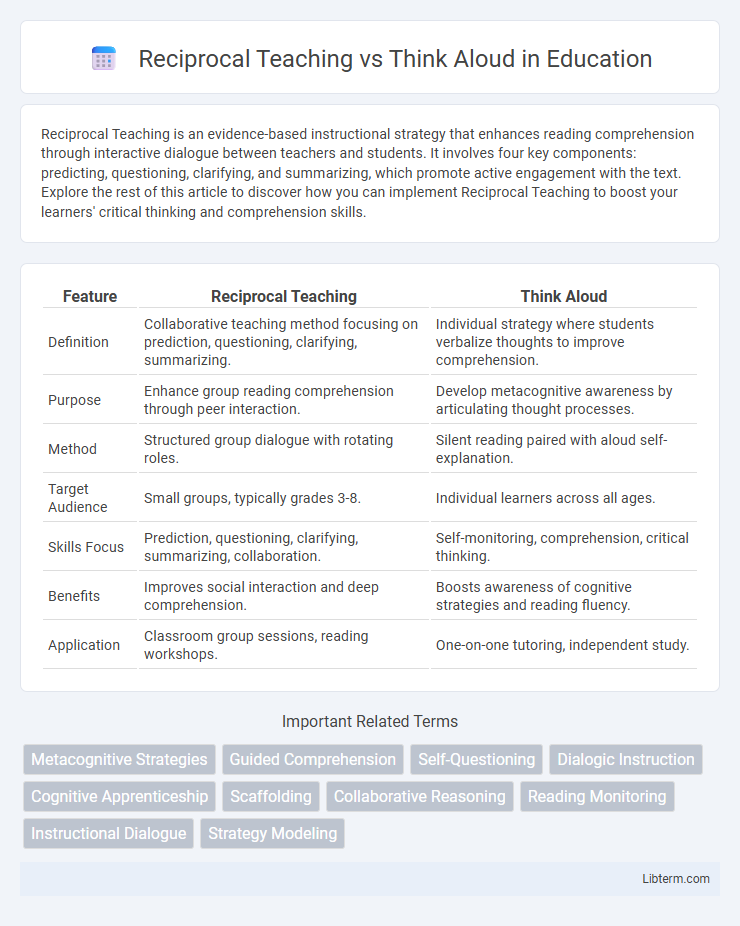Reciprocal Teaching is an evidence-based instructional strategy that enhances reading comprehension through interactive dialogue between teachers and students. It involves four key components: predicting, questioning, clarifying, and summarizing, which promote active engagement with the text. Explore the rest of this article to discover how you can implement Reciprocal Teaching to boost your learners' critical thinking and comprehension skills.
Table of Comparison
| Feature | Reciprocal Teaching | Think Aloud |
|---|---|---|
| Definition | Collaborative teaching method focusing on prediction, questioning, clarifying, summarizing. | Individual strategy where students verbalize thoughts to improve comprehension. |
| Purpose | Enhance group reading comprehension through peer interaction. | Develop metacognitive awareness by articulating thought processes. |
| Method | Structured group dialogue with rotating roles. | Silent reading paired with aloud self-explanation. |
| Target Audience | Small groups, typically grades 3-8. | Individual learners across all ages. |
| Skills Focus | Prediction, questioning, clarifying, summarizing, collaboration. | Self-monitoring, comprehension, critical thinking. |
| Benefits | Improves social interaction and deep comprehension. | Boosts awareness of cognitive strategies and reading fluency. |
| Application | Classroom group sessions, reading workshops. | One-on-one tutoring, independent study. |
Introduction to Reciprocal Teaching and Think Aloud
Reciprocal Teaching is an interactive instructional strategy that promotes reading comprehension by engaging students in summarizing, questioning, clarifying, and predicting within a collaborative group setting. Think Aloud involves students verbalizing their thought processes while reading to enhance metacognitive awareness and self-regulation during text comprehension. Both methods aim to improve understanding but differ in interactive focus and the level of peer collaboration.
Core Principles of Reciprocal Teaching
Reciprocal Teaching centers on four core principles: predicting, questioning, clarifying, and summarizing, designed to enhance reading comprehension through guided dialogue between teacher and students. This collaborative approach contrasts with Think Aloud, which emphasizes individual cognitive modeling by verbalizing thoughts during reading. Reciprocal Teaching fosters interactive engagement and strategy sharing, making it more effective for developing critical thinking and metacognitive skills in group settings.
Key Features of Think Aloud Strategy
Think Aloud strategy emphasizes verbalizing thought processes during reading to enhance comprehension and metacognitive awareness. Key features include articulating predictions, clarifying confusing parts, summarizing content, and questioning the text to foster deeper engagement. Unlike Reciprocal Teaching, which relies on group dialogue and role interchange, Think Aloud focuses on individual cognitive monitoring through self-explanation.
Implementation Techniques: Reciprocal Teaching
Reciprocal Teaching involves structured group interactions where students alternate roles such as predictor, questioner, clarifier, and summarizer to foster comprehension and critical thinking. Implementation techniques emphasize modeling by the teacher, guided practice, and gradual release of responsibility to ensure students internalize questioning and summarization strategies. Effective use of reciprocal teaching integrates scaffolding and feedback, encouraging collaborative dialogue and active engagement with texts.
Implementation Techniques: Think Aloud
Think Aloud implementation involves teachers verbalizing their thought processes during reading to model comprehension strategies such as predicting, questioning, clarifying, and summarizing. This technique requires explicit instructor demonstration followed by guided student practice to internalize metacognitive skills. Frequent practice sessions enhance students' ability to independently monitor understanding and apply strategic thinking across texts.
Cognitive Processes in Both Approaches
Reciprocal Teaching engages cognitive processes such as predicting, questioning, clarifying, and summarizing to enhance comprehension through collaborative dialogue, promoting active metacognitive regulation. Think Aloud emphasizes real-time verbalization of cognitive strategies, enabling learners to externalize reasoning, monitor understanding, and self-correct during reading. Both approaches foster metacognitive awareness but differ as Reciprocal Teaching relies on group interaction, while Think Aloud centers on individual cognitive processing and articulation.
Comparative Benefits for Student Comprehension
Reciprocal Teaching enhances student comprehension by actively engaging learners in predicting, questioning, clarifying, and summarizing text, fostering collaborative learning and critical thinking skills. Think Aloud improves understanding by modeling metacognitive strategies aloud, allowing students to internalize reasoning and improve self-monitoring during reading. Both methods strengthen comprehension, but Reciprocal Teaching emphasizes interactive dialogue, while Think Aloud focuses on individual cognitive processes.
Classroom Applications and Practical Examples
Reciprocal Teaching enhances comprehension through structured dialogue where students alternate roles in predicting, questioning, clarifying, and summarizing text, fostering collaborative learning in small groups. Think Aloud encourages metacognitive awareness as teachers verbalize their thought processes during reading, modeling strategies like inference and decoding for students in diverse subjects. Both approaches improve literacy skills, with Reciprocal Teaching promoting peer interaction and Think Aloud supporting individualized understanding, often combined to maximize student engagement and critical thinking in classrooms.
Challenges and Limitations of Each Method
Reciprocal Teaching faces challenges such as requiring extensive teacher training for effective implementation and difficulty maintaining student engagement during group interactions, which may limit comprehension improvements. Think Aloud is constrained by its reliance on students' verbalization skills, leading to incomplete or inaccurate expression of cognitive processes and potential disruption of natural reading flow. Both methods can be time-consuming, with Reciprocal Teaching demanding consistent practice for skill mastery and Think Aloud risking reduced reading speed and comprehension due to frequent pauses.
Choosing the Right Strategy: Factors to Consider
Choosing the right strategy between Reciprocal Teaching and Think Aloud depends on students' cognitive levels, learning objectives, and the desired interaction type. Reciprocal Teaching enhances comprehension through structured dialogue and prediction, while Think Aloud supports self-monitoring by verbalizing thought processes. Educators should assess student readiness, text complexity, and instructional goals to determine the most effective approach for fostering critical thinking and metacognitive skills.
Reciprocal Teaching Infographic

 libterm.com
libterm.com